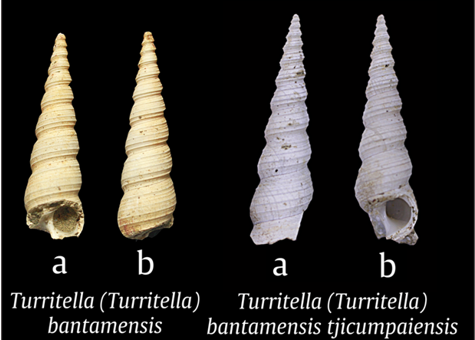Depositional Environmental Changes of Cimanceuri Formation Based on Mollusk Fossil Assemblages in Bayah, Banten Province
DOI:
https://doi.org/10.25299/jgeet.2019.4.2.2986Keywords:
Mollusk, Depositional environment, Bayah, Cimanceuri FormationAbstract
Bayah is located in Lebak Regency, Banten Province. This location is chosen due to its abundant mollusk fossils which exposed along the outcrops. The aim of this research is to determine depositional environmental changes using mollusk fossil assemblages. Data obtained from a measured stratigraphic section of Cimanceuri Formation. It is dominated by very fine-fine sandstones with claystone intercalation. A total thickness of measured stratigraphic section is 4.2 meters. There are at least seventeen mollusk associations (bottom-top) consisting of 1) Ringicula arctatoides - Olivella tomlini were obtained. 2) Ringicula arctatoides - Marginella (Cryptospira) ventricosa sangiranensis. 3) Olivella tomlini, 4) Ringicula arctatoides - Olivella tomlini, 5) Ringicula arctatoides, 6) Turritella (Turritella) bantamensis - Scapharca (Scapharca) gedinganensis, 7) Polinices aurantius - Marginella (Cryptospira) ventricosa sangiranensis, 8) Scapharca (Scapharca) gedinganensis, 9) Scapharca (Scapharca) multiformis - Timoclea bataviana, 10) Turritella (Turritella) bantamensis tjicumpaiensis - Ringicula arctatoides, 11) Turritella (Turritella) bantamensis - Ringicula arctatoides, 12) Turritella (Turritella) bantamensis tjicumpaiensis - Turritella (Turritella) bantamensis, 13) Turritella (Turritella) bantamensis tjicumpaiensis - Ringicula arctatoides, 14) Turritella (Turritella) bantamensis - Architectonica sp., 15) Turritella (Turritella) bantamensis tjicumpaiensis, 16) Turritella (Turritella) bantamensis – Turritella (Turritella) bantamensis tjicumpaiensis, and 17) Turritella (Turritella) bantamensis. The condition with the most stable ecosystem is the association of Turritella (Turritella) bantamensis tjicumpaiensis - Turritella (Turritella) bantamensis (Association 12). At least there are seven depositional environmental changes that occur in this research area with two shallowing – deepening cycles : 1) open shallow marine, 2) subtidal – open shallow marine, 3) open shallow marine, 4) open shallow marine – subtidal, 5) subtidal, 6) subtidal – open shallow marine, and 7) open shallow marine.
Downloads
References
Aswan, Ozawa, T., 2006. Milankovitch 41000-year cycles in lithofacies and molluscan content in the tropical Middle Miocene Nyalindung Formation, Jawa, Indonesia. Palaeogeogr. Palaeoclimatol. Palaeoecol. 235, 382–405. https://doi.org/10.1016/j.palaeo.2005.11.004
Aswan, Sufiati, E., Rudyawan A., Kistiani D., and Thaw Zin Oo. 2018. Depositional environmental evolution of Kalibiuk formation based on paleontological molluscan Study, Cisaat River section, Bumiayu, Central Java, Indonesia. IOP Conf. Series: Earth and Environmental Science 162 (2018) 012033. DOI:10.1088/1755-1315/162/1/012033
Bakus, G.J., 2007. Quantitative Analysis of Marine Biological Communities: Field Biology and Environment. John Wiley & Sons, Inc., Hoboken, NJ, USA. https://doi.org/10.1002/0470099186
Fan, D. 2012. Open-Coast Tidal Flats. Principles of Tidal Sedimentology, 187–229. Springer Science & Business Media
Jurnaliah, L. 2011. Diversitas Foraminifera Bentonik Kecil di Daerah Perairan Semarang (Lembar 1409) Jawa Tengah (Diversity Small Benthonic Foraminifera in Semarang Sea). Bulletin of Scientific Contribution, vol.9, Desember 2011: 121-124
Leloux, J. and Wesselingh, F. P. 2009. Types of Cenozoic Mollusca from Java in the Martin Collection of Naturalis. NNM Technical Bulletin, 11: 1-765, Leiden.
Martin, K. 1879-1880. Die Tertia Rschicten auf Java. Nach den Entdeckungen von F. Junghuhn. Paleontologischer Theil. Geologische-Reichsmuseum, Leiden. ix+164+51+6.
Martodjojo, S. 2003. Evolusi Cekungan Bogor Jawa Barat. Penerbit ITB Bandung.
Morley, R. J., Morley, H. P. and Swiecicki, T. 2016. Mio-Pliocene Palaeogeography, Uplands and River Systems of The Sunda Region Based on Mapping Within a Framework of Vim Depositional Cycles. Proceedings, Indonesian Petroleum Association Fortieth Annual Convention & Exhibition.
Okutani, T., 2000. Marine Mollusks in Japan. Tokyo: Tokai University Press.
Oostingh, C. H. 1938. Mollusken Als Gidsfossielen Voor Het Neogeen in Nederlandsh Indie (Surabaya: Handelingen Van Het Achtste Nederlandsch – Indisch Natuur Wetenschappelijk Congres).
Prasetyo U., Aswan, Zaim, Y. & Rizal, Y., 2012, Perubahan Lingkungan Pengendapan pada Beberapa Daerah di Pulau Jawa Selama Plio-Plistosen Berdasarkan Kajian Paleontologi Moluska. (Depositional Environmental Changes in Java during Plio-Pleistocene based on Paleontological Mollusk). Jurnal Teknologi Mineral (JTM), XIX, 173-180, Bandung.
Roza, S. E. V, Abdurrokhim. 2015. Penentuan Perubahan Ketinggian Air Laut Berdasarkan Analisis Foraminifera Bentonik. Seminar Nasional ke-II Fakultas Teknik Geologi Universitas Padjadjaran
Shuto, T., 1975. Preliminary correlation of the Neogene molluscan faunas in Southeast Asia. Contributions to the geology and palaeontology of Southeast Asia, CLV. Geology and Palaeontology of Southeast Asia, 161– 173.
Sufiati, E., Prasetyo, U., Kistiani, D., Aripin, dan Irman. 2014. Penelitian Fosil Moluska Di Kecamatan Bayah, Kabupaten Lebak, Propinsi Banten. Laporan Kegiatan Lapangan Museum Geologi Bandung, unpublished.
Sujatmiko & Santosa S. 1992. Peta Geologi Lembar Leuwidamar, Jawa (Geological Map of Leuwidamar Quadrangle, Java). Bandung: Pusat Penelitian dan Pengembangan Geologi.
Zhong, G., Geng, J., Wong, H. K., Ma, Z., and Wu, N. 2004. A semi-quantitative method for the reconstruction of eustatic sea level history from seismic profiles and its application to the southern South China Sea. Earth and Planetary Science Letters 223 (2004) 443– 459. doi:10.1016/j.epsl.2004.04.039

Downloads
Published
Issue
Section
License
Copyright @2019. This is an open-access article distributed under the terms of the Creative Commons Attribution-ShareAlike 4.0 International License which permits unrestricted use, distribution, and reproduction in any medium. Copyrights of all materials published in JGEET are freely available without charge to users or / institution. Users are allowed to read, download, copy, distribute, search, or link to full-text articles in this journal without asking by giving appropriate credit, provide a link to the license, and indicate if changes were made. All of the remix, transform, or build upon the material must distribute the contributions under the same license as the original.










